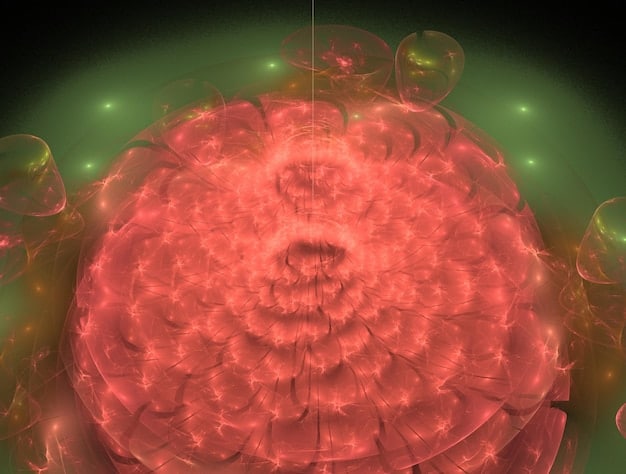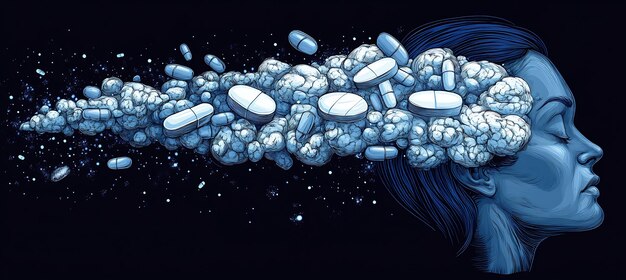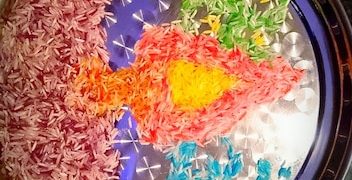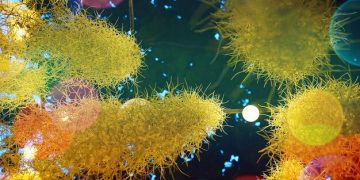The Science of Addiction: Brain Mechanisms, Reward Systems, and Recovery

The Science of Addiction: Understanding the Brain’s Reward System and Recovery Strategies reveals how addictive substances hijack the brain’s reward pathways, leading to compulsive behaviors, while also exploring effective strategies for restoring healthy brain function and achieving lasting recovery.
The complexities of addiction can often feel overwhelming, leaving many struggling to understand its grip. The Science of Addiction: Understanding the Brain’s Reward System and Recovery Strategies aims to unravel this complexity, offering insights into how addiction affects the brain and exploring paths toward recovery.
Understanding the Neuroscience of Addiction
Addiction is a complex condition that affects millions worldwide. It’s not simply a matter of willpower or moral failing; it’s a chronic disease that fundamentally changes the brain’s structure and function. Understanding the neuroscience behind addiction is crucial for developing effective prevention and treatment strategies.
The Role of Neurotransmitters
Neurotransmitters are chemical messengers that transmit signals between neurons in the brain. Certain neurotransmitters, particularly dopamine, play a significant role in the reward system and the development of addiction.
- Dopamine: Often referred to as the “feel-good” neurotransmitter, dopamine is released when we experience pleasurable activities such as eating, socializing, or achieving goals.
- Serotonin: Regulates mood, sleep, and appetite. Imbalances in serotonin levels can contribute to depression and anxiety, which may increase the risk of addiction.
- GABA: An inhibitory neurotransmitter that helps calm the brain. Some addictive substances enhance GABA activity, leading to relaxation and reduced anxiety.

The actions of these neurotransmitters lead to behavioral changes, ultimately shaping the addiction cycle. Understanding the roles and impacts of dopamine, serotonin, and GABA is essential for uncovering effective strategies for recovery and therapeutic intervention.
The Brain’s Reward System and Addiction
The brain’s reward system is a network of structures that reinforce behaviors necessary for survival, such as eating and reproduction. However, addictive substances can hijack this system, leading to intense cravings and compulsive drug-seeking behavior.
How Addictive Substances Hijack the Reward System
Addictive substances can cause a surge of dopamine in the brain’s reward center, creating an intense feeling of pleasure. Over time, the brain adapts to this excessive dopamine release, reducing the sensitivity of reward circuits.
- Tolerance: The brain requires more of the substance to achieve the same pleasurable effect.
- Dependence: The brain relies on the substance to function normally, leading to withdrawal symptoms when it is discontinued.
- Craving: An intense desire or urge to use the substance, often triggered by environmental cues or stress.
Continuous and excessive triggering of the reward system leads to long-term structural and functional changes in the brain. These changes can result in impaired impulse control, altered decision-making, and a relentless pursuit of the addictive substance, overshadowing other important activities and relationships.
The Stages of Addiction
Addiction typically progresses through several stages, each characterized by distinct behaviors and neurological changes. Understanding these stages can help individuals and their loved ones recognize the signs of addiction and seek appropriate help.
Experimentation
This initial stage involves trying the substance for the first time, often out of curiosity or social pressure. The rewarding effects can make the substance appealing and encourage further use.
Regular Use
As use becomes more frequent, the individual may begin to rely on the substance to cope with stress or negative emotions. Tolerance and dependence can start to develop during this stage.
Problem or Risky Use
At this stage, the individual experiences negative consequences as a result of their substance use, such as problems at work, school, or in relationships. They may also engage in risky behaviors, such as driving under the influence.
Addiction
This is the most severe stage, characterized by compulsive drug-seeking behavior and a loss of control over substance use. The individual prioritizes the substance above all else, often neglecting responsibilities and relationships. Withdrawal symptoms can be intense and debilitating.
Genetic and Environmental Factors in Addiction
Addiction is not caused by a single factor; rather, it is the result of a complex interplay between genetic predisposition and environmental influences. Identifying these factors can help understand who is at risk and how to prevent addiction.
Genetic Predisposition
Research suggests that genetics can account for up to 40-60% of the risk for addiction. Certain genes can affect the way the brain responds to addictive substances, making some individuals more vulnerable than others.
Environmental Influences
Environmental factors, such as family history of addiction, exposure to trauma, and social environment, can also significantly increase the risk of addiction. Supportive relationships and positive role models can provide protection against addiction.

Genetic backgrounds and the surrounding environments create a multifaceted scenario in addiction. Awareness of both genetic vulnerabilities and potential influences can allow for preventative measures to be taken, particularly in high-risk settings.
Strategies for Addiction Recovery
Recovery from addiction is a challenging but achievable process. A variety of evidence-based treatments and support systems can help individuals overcome addiction and lead fulfilling lives.
Therapy and Counseling
- Cognitive-Behavioral Therapy (CBT): Helps individuals identify and change negative thought patterns and behaviors that contribute to addiction.
- Motivational Interviewing (MI): Enhances motivation to change by exploring ambivalence and building commitment to recovery.
- Group Therapy: Provides a supportive environment where individuals can share their experiences and learn from others in recovery.
Medication-Assisted Treatment (MAT)
MAT involves the use of medications, in combination with therapy, to reduce cravings and withdrawal symptoms. Medications such as methadone, buprenorphine, and naltrexone are commonly used to treat opioid addiction.
Support Groups
Support groups, such as Alcoholics Anonymous (AA) and Narcotics Anonymous (NA), provide a peer-support network where individuals can share their struggles and successes. These groups offer accountability and encouragement throughout the recovery process.
Developing a comprehensive treatment plan that addresses both the physical and psychological aspects of addiction is vital for long-term recovery. These methods, in addition to other holistic measures, provide individuals with necessary tools and support so they may strive towards a life free from addiction.
Preventing Relapse
Relapse is a common part of the recovery process, but it doesn’t have to be a setback. Developing strategies to prevent relapse is essential for maintaining long-term sobriety.
Identifying Triggers
Triggers are people, places, or situations that can cue cravings and increase the risk of relapse. Learning to identify and avoid triggers is crucial for preventing relapse.
Developing Coping Skills
Coping skills, such as relaxation techniques, exercise, and hobbies, can help manage stress and negative emotions without turning to addictive substances.
Building a Support Network
A strong support network of family, friends, and peers in recovery can provide encouragement and accountability during challenging times. Staying connected to others can help prevent isolation and loneliness, which are common relapse triggers.
| Key Point 💡 | Brief Description |
|---|---|
| 🧠 Brain’s Reward System | Addictive substances hijack the reward system, stimulating dopamine release. |
| 🌱 Genetic & Environmental Factors | Genetics and environment both contribute to addiction risk; awareness is key. |
| 🛡️ Strategies for Recovery | Therapy, Medication-Assisted Treatment (MAT), and Support Groups aid recovery journey. |
| 🔄 Preventing Relapse | Identifying triggers and building coping skills are essential to prevent relapse. |
Frequently Asked Questions (FAQ)
▼
Dopamine is a neurotransmitter associated with pleasure and reward. Addictive substances flood the brain with dopamine, creating intense pleasure, which reinforces substance-seeking behavior.
▼
Genetics can account for 40-60% of addiction risk. Genes influence how the brain processes rewards and handles stress, increasing vulnerability if certain genes are present.
▼
Effective treatments include cognitive-behavioral therapy (CBT), motivational interviewing (MI), medication-assisted treatment (MAT), and participation in support groups like AA/NA.
▼
Relapse is a return to substance use after a period of abstinence. It can be prevented by identifying triggers, developing coping skills, and building a strong support network.
▼
A supportive environment offers encouragement, accountability, and reduces the risk of isolation. Family, friends, and peers in recovery provide valuable support to achieve long-term sobriety.
Conclusion
Understanding the science of addiction offers critical insights into how addictive substances hijack the brain’s reward system and drive compulsive behaviors. By recognizing the interplay of genetic and environmental factors, and by utilizing evidence-based treatment and relapse prevention strategies, individuals can pave the way for lasting recovery and a brighter, substance-free future.





